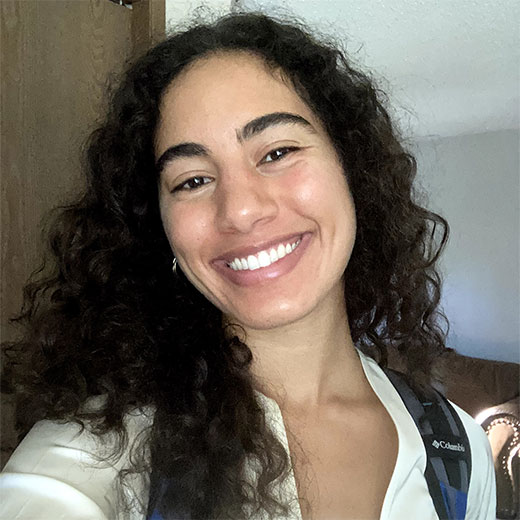Impact of COVID-19 on Medical Student Training in Obstetrics and Gynaecology

Commentary by Yesmine Elloumi, BSc
This summer I had the exciting opportunity to travel to Quebec City as a medical student to attend the Society of Obstetricians and Gynaecologists Annual Clinical and Scientific Conference. I recently discovered my passion for obstetrics and gynecology (OB-GYN) back in March of this year while on my core clerkship rotations and this was a fantastic opportunity for me to explore the specialty of OB-GYN beyond our standard curriculum. At the opening reception, I met Dr. Maggie Morris, former SOGC President, who was interested in hearing about how COVID-19 affected medical students’ training.
The majority of my pre-clerkship training was through “Zoom school” where I was not allowed to be a part of clinical environments until I started my clerkship training in August 2021. Therefore, the first thought that came to mind was a lack of clinical exposure coupled with a lack of mentors who could shed light on clinical settings. This made the “big black box of clerkship” that much bigger. Not being able to shadow different specialties meant not being exposed to day-to-day clinical scenarios or how medical students fit into the treatment team. It also meant a lack of awareness of basic knowledge such as the layout of different hospital sites and where to find scrubs.
Given the strain that the COVID-19 pandemic placed on the entire healthcare system, our class was cognisant of our need to acclimatize to a novel learning environment to be successful medical students in training.
There is no doubt that COVID-19 has caused significant burnout in healthcare workers. Surprisingly, I witnessed attendings and residents masterfully hide the immense strain they were under. Their ability to stay present and professional to meet the needs of their patients and their team reflects strongly on the resiliency they practice.
However, I started to wonder if their burnout was manifesting in other ways. I felt I was not getting as much bedside teaching, career advice, or insightful conversations with staff as I had hoped. I realized that I needed to adapt to this altered learning environment to become a useful team member and show my interest in the specialty.
Some of my strategies included befriending nurses which helped me immensely with orienting to different units and operating room (OR) suites, leaning on off service residents to review topics in OB-GYN, practicing surgical skills with my cohort throughout the rotation, and consistently asking residents and staff for feedback when they made themselves available. I found that asking for advice was a nerve-wracking, yet effective way to connect with senior colleagues who otherwise had little energy for teaching and coaching.
In addition to burnout, I noticed that there was more of a hierarchy dynamic being displayed by the loss of OR opportunities for residents and medical students. Many first-year residents I worked with explained that they had been primarily assisting surgeons and chief residents for much of their training thus far.
The lack of OR time and the need for skilled physicians to take the lead in the unprecedented context which was the pandemic led to many residents being pushed behind to support the team in ways other than they had expected. Additionally, chief and senior residents were prioritized for learning opportunities to ensure they achieved necessary competencies to graduate, which they were also delayed in due to the restrictions of the pandemic. I hope that as our healthcare system gains a better sense of balance with the consequences of COVID-19, equitable learning opportunities for trainees become a priority.
Fortunately, a strength of many Canadian medical schools is that medical students and residents both train under competency-based medical education (CBME), which is a framework that ensures trainees reach observed objectives at each level of training. It will be important for medical students and their seniors to consistently work within the CBME framework to continue creating productive and streamlined learning environments for future physicians.
In conclusion, the main message that I hope to share from my reflections as an “OB-GYN gunner” going through clinical training during the COVID-19 pandemic is the importance of empathy. I understand that many of my former points were not especially optimistic, and I do not know what clerkship was like before COVID-19. What I do know is that we have been immersed in a not-so ideal healthcare system that depends on human beings who are living a human experience. It is important to not only have empathy for the challenges that the pandemic has brought to the healthcare system, but also to have compassionate empathy for each human being that we get to work with and learn from every day.
As a medical student, it is easy for me to expect my attendings and residents to be ready to teach me whenever we work together. That is what I am doing clerkship for, right? The reality is that as trainees, we are learning from residents and attendings who are managing units of patients, medical and surgical emergencies with constantly changing pandemic procedures, all on top of their own personal commitments as spouses, parents, siblings, and more. We do not need to know the details of each other’s stressors to know that empathy and kindness to one another will be the strongest tools of perseverance. And of course, observation is in itself a great learning experience.
With this, I hope that any readers who provide training to medical students keep in mind the challenges that we have faced during our training and the immeasurable value of kindness to our blunders along the way. I am filled with gratitude for the individuals who have taken the time to highlight my strengths and provide constructive feedback for my weaknesses and I look forward to when I too can provide coaching to medical trainees in the future.
